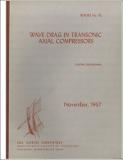| dc.contributor.author | Okurounmu, Olufemi | en_US |
| dc.contributor.other | Massachusetts Institute of Technology. Gas Turbine Laboratory | en_US |
| dc.date.accessioned | 2016-10-06T21:21:56Z | |
| dc.date.available | 2016-10-06T21:21:56Z | |
| dc.date.issued | 1967 | en_US |
| dc.identifier.uri | http://hdl.handle.net/1721.1/104683 | |
| dc.description | November 1967 | en_US |
| dc.description | Also issued as: Thesis (Sc. D.)--Massachusetts Institute of Technology, Dept. of Mechanical Engineering, 1968 | en_US |
| dc.description | Includes bibliographical references | en_US |
| dc.description.abstract | Profiles of fluid properties, including flow angle, static and total pressures have been obtained behind a free wheeling 8" diameter transonic rotor. The latter consists of 40 blades with double circular arc profiles, a hub to tip diameter ratio of 0.80 and a mean solidity of 0.94. The variation of stagger angle along the blade span is such that the local relative velocity is aligned with the blade chord at a design point corresponding to an inlet axial Mach number of 0.6 and a rotor speed of 35,000 RPM. The profiles show strong evidence of the existence of standing acoustic waves in the flow passage at transonic relative Mach numbers. A strong drag rise is observed at subsonic relative Mach numbers (MT) close to unity, the slope of the drag curve being negative at MT = 1, but turning positive again shortly after MT = 1. For MT < 1, a remarkably good correlation is observed between the spanwise mean of the measured drag and previous 2-D pressure drag measurements on similar profiles. At low supersonic relative Mach numbers, the drag due to shocks in the blade passages appears to overshadow the wave drag, and as yet, there is no definitive way to isolate the contribution of the wave drag experimentally. Computed values of the wave drag at these speeds, based on McCune's analysis for a non-lifting blade row, are "compared" with the measured drag. A linearized theory is presented for obtaining the induced drag of an axial compressor blade row subjected to- any- arbitrary blade loading distribution. The blades are replaced at their leading edges by bound vortex lines of varying strength along the span, and the induced drag obtained from the induced velocity field of the resulting trailing helical vortex sheets. Use of this lifting line approach restricts the useful range of the theory to relative Mach numbers less than unity, since such a quasi 2-D theory would not be applicable to transonic flows which are believed to be inherently three dimensional. | en_US |
| dc.description.sponsorship | Under the Sponsorship of: General Electric Company Allison Division of General Motors Company | en_US |
| dc.format.extent | 1 volume ([159] pages in various pagings) | en_US |
| dc.publisher | Cambridge, Mass. : Massachusetts Institute of Technology, Gas Turbine Laboratory, [1967] | en_US |
| dc.relation.ispartofseries | GTL report #92 | en_US |
| dc.subject.lcc | TJ267.A1 M37 no.92 | en_US |
| dc.subject.lcsh | Compressors -- Blades | en_US |
| dc.subject.lcsh | Drag (Aerodynamics) | en_US |
| dc.title | Wave drag in transonic axial compressors | en_US |
| dc.type | Technical Report | en_US |
| dc.identifier.oclc | 09165741 | en_US |
